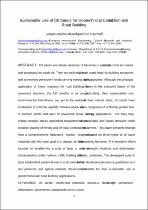JavaScript is disabled for your browser. Some features of this site may not work without it.
- ResearchSpace
- →
- Research Publications/Outputs
- →
- Journal Articles
- →
- View Item
| dc.contributor.author |
Anochie-Boateng, Joseph

|
|
| dc.contributor.author |
Tutumluer, E

|
|
| dc.date.accessioned | 2012-10-12T08:57:12Z | |
| dc.date.available | 2012-10-12T08:57:12Z | |
| dc.date.issued | 2012-02 | |
| dc.identifier.citation | Anochie-Boateng, J and Tutumluer, E. 2012. Sustainable use of oil sands for geotechnical construction and road building. Journal of ASTM International, vol. 9(2), DOI: 10.1520/JAI103651 | en_US |
| dc.identifier.issn | 1546-962X | |
| dc.identifier.uri | http://www.astm.org/DIGITAL_LIBRARY/JOURNALS/JAI/PAGES/JAI103651.htm | |
| dc.identifier.uri | http://hdl.handle.net/10204/6138 | |
| dc.description | Coopyright: 2012 ASTM. This is the post-print version of the work. The definitive version is published in Journal of ASTM International, vol. 9(2), DOI: 10.1520/JAI103651 | en_US |
| dc.description.abstract | Oil sands are natural deposits of bituminous sand materials that are mined and processed for crude oil. They are routinely used in oil sand fields for building temporary and sometimes permanent roads serving mining and hauling activities. Although the principal application of these materials for road building has been in the unbound layers of the pavement structure, the full benefits of oil sands, particularly, their sustainability and environmental friendliness are yet to be realized. In their natural state, oil sands have similarities to cold mix asphalt mixtures which are often comprised of uniformly graded fine to medium sands and used for pavement repair and patching applications. Yet, they may exhibit complex stress dependent characteristics and viscoelastic and plastic behavior under dynamic loading of mining and off-road construction equipment. This paper presents findings from a comprehensive laboratory research program conducted on three types of oil sand materials with the main goal to characterize their engineering behavior. The research efforts focused on establishing a suite of tests to determine strength, modulus and deformation characteristics under realistic traffic loading and climatic conditions. The developed suite of tests established essential trends in oil sand behavior for developing laboratory guidelines and test protocols and typical material characterization models for their sustainable use in geotechnical and road building applications. | en_US |
| dc.language.iso | en | en_US |
| dc.publisher | ASTM International | en_US |
| dc.relation.ispartofseries | Workflow;9656 | |
| dc.subject | Oil sands | en_US |
| dc.subject | Bituminous materials | en_US |
| dc.subject | Modulus | en_US |
| dc.subject | Shear strength | en_US |
| dc.subject | Permanent deformation | en_US |
| dc.subject | Pavement structure | en_US |
| dc.subject | Sustainable construction | en_US |
| dc.subject | Road building | en_US |
| dc.title | Sustainable use of oil sands for geotechnical construction and road building | en_US |
| dc.type | Article | en_US |
| dc.identifier.apacitation | Anochie-Boateng, J., & Tutumluer, E. (2012). Sustainable use of oil sands for geotechnical construction and road building. http://hdl.handle.net/10204/6138 | en_ZA |
| dc.identifier.chicagocitation | Anochie-Boateng, Joseph, and E Tutumluer "Sustainable use of oil sands for geotechnical construction and road building." (2012) http://hdl.handle.net/10204/6138 | en_ZA |
| dc.identifier.vancouvercitation | Anochie-Boateng J, Tutumluer E. Sustainable use of oil sands for geotechnical construction and road building. 2012; http://hdl.handle.net/10204/6138. | en_ZA |
| dc.identifier.ris | TY - Article AU - Anochie-Boateng, Joseph AU - Tutumluer, E AB - Oil sands are natural deposits of bituminous sand materials that are mined and processed for crude oil. They are routinely used in oil sand fields for building temporary and sometimes permanent roads serving mining and hauling activities. Although the principal application of these materials for road building has been in the unbound layers of the pavement structure, the full benefits of oil sands, particularly, their sustainability and environmental friendliness are yet to be realized. In their natural state, oil sands have similarities to cold mix asphalt mixtures which are often comprised of uniformly graded fine to medium sands and used for pavement repair and patching applications. Yet, they may exhibit complex stress dependent characteristics and viscoelastic and plastic behavior under dynamic loading of mining and off-road construction equipment. This paper presents findings from a comprehensive laboratory research program conducted on three types of oil sand materials with the main goal to characterize their engineering behavior. The research efforts focused on establishing a suite of tests to determine strength, modulus and deformation characteristics under realistic traffic loading and climatic conditions. The developed suite of tests established essential trends in oil sand behavior for developing laboratory guidelines and test protocols and typical material characterization models for their sustainable use in geotechnical and road building applications. DA - 2012-02 DB - ResearchSpace DP - CSIR KW - Oil sands KW - Bituminous materials KW - Modulus KW - Shear strength KW - Permanent deformation KW - Pavement structure KW - Sustainable construction KW - Road building LK - https://researchspace.csir.co.za PY - 2012 SM - 1546-962X T1 - Sustainable use of oil sands for geotechnical construction and road building TI - Sustainable use of oil sands for geotechnical construction and road building UR - http://hdl.handle.net/10204/6138 ER - | en_ZA |






